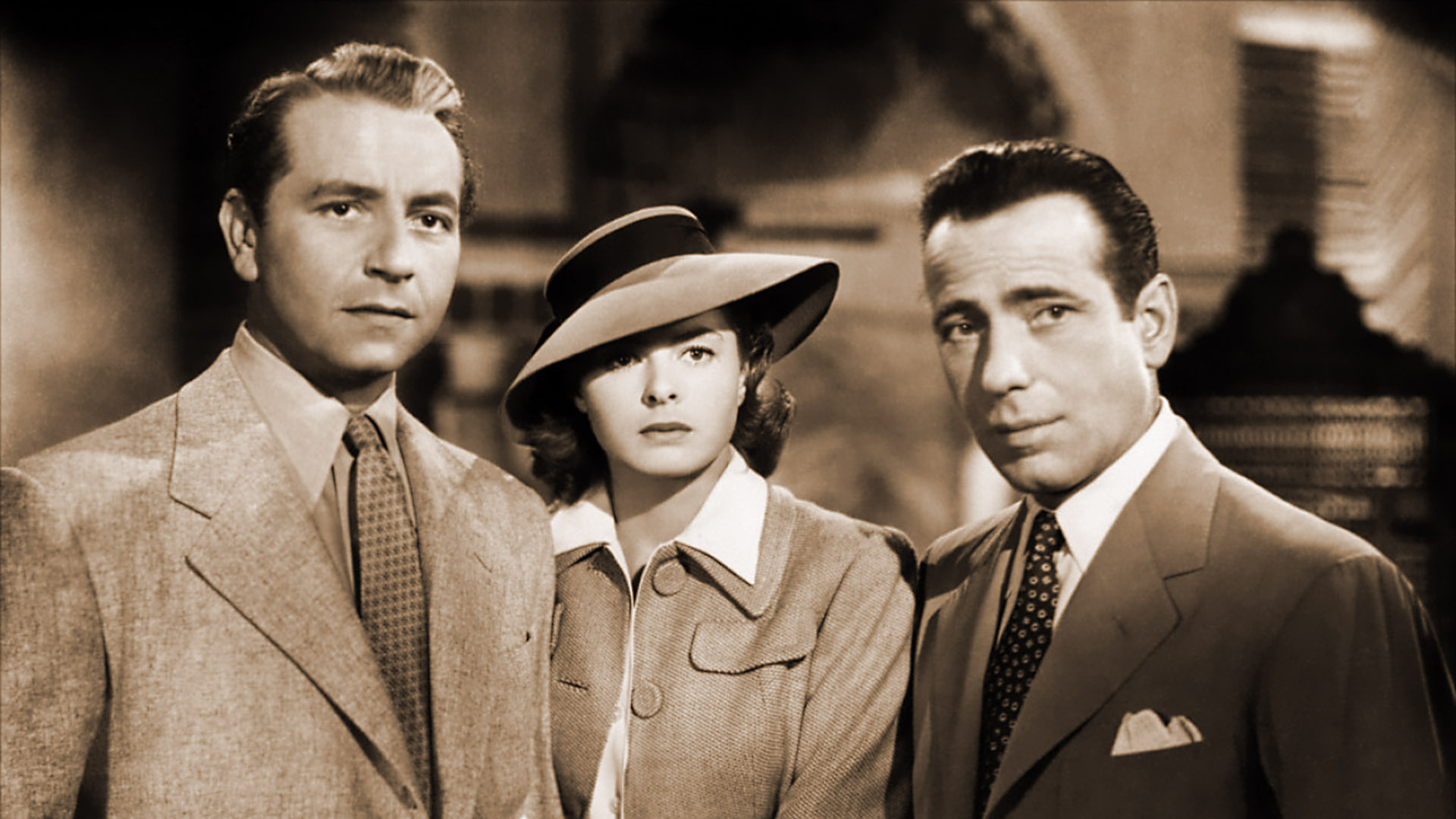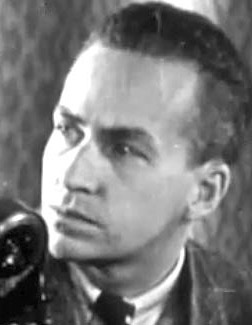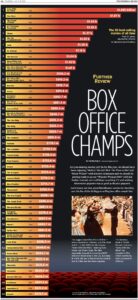
Paul Henreid, Ingrid Bergman and Humphrey Bogart in the cinema classic Casablanca. The theme of fighting for freedom against the Nazis is set against an intriguing romantic triangle.
Cinema clobbers the senses, influencing the way people perceive each other and their environment like no other medium. From the Lumière brothers to the Cohn brothers, from Hollywood to Bollywood, from the Oscars to the Cannes Film Festival, the story of cinema parallels the social revolutions and political struggles of the 20th and 21st centuries.
Cinema on this site
- Early experiments
- The silent era
- Animation
- The Golden Age of Hollywood
- European Cinema
- WWII Era
- 1960s and 70s
- Blockbusters
Discussion questions
- Historical reframing: HBO offers movies like “Gone With the Wind” for streaming. But in June, 2020, HBO pulled the movie with the intention of reframing it, according to the Washington Post. How do you think GWTW should be presented in historical context?
- Hot or not? Is cinema considered a hot medium, according to McLuhan? Why or why not?
- Racism in the movies: Compare the overt racism of Birth of a Nation to the racism in Jazz Singer. Are there differences? Consider the context of the times as well as the modern perspective. Also consider documentaries like: Small Steps, Big Strides; Reel Injun; and The Slanted Screen.
- Women in the movies: Why have directors like Alice Guy-Blaché been forgotten? (And who is working to revive their memory?)
- Anti-heroes: What is an anti-hero? Why did the simpler portrayals of heroes before World War II give way to more nuanced and often grittier depictions of people in heroic roles in the 1960s and 70s?
- Anti-Trust and lack of trust: What broke up the Hollywood studio system? What was HUAC?
- Curves in the road: How did Hollywood studios miss the curve in the digital road in terms of special effects in the 1970s? Or the impact of streaming in the 2010s?
Review: People and events
Thomas Edison, George Eastman, Auguste & Louis Lumiere, George Melies, Oscar Micheaux, D.W. Griffith, Charlie Chaplin, the Marx Brothers, Orson Welles, Walt Disney, Leni Riefenstahl, Frank Capra, Clark Gable, Dalton Trumbo,
Early film censorship, Edison Trust, MPAA code, silent film era, “talkies,” animation, Golden Age, Propaganda, Citizen Kane, HUAC hearings, special effects blockbusters, end of the mass audience
Documentary videos
- Library of Congress online film collection
- Library of Congress online audio recordings collections
- Archive.org movie and television collection
——————- - The Story of Film – by Mark Cousins, (available on Kanopy, through your library), 2011. Very highly recommended as an overview of the people and struggles of a complicated time in Hollywood. The documentary is about innovation, people, industry and technology. Described as a bold 15-part love letter to the movies, The Story of Film begins with the invention of motion pictures at the end of the 19th century and concludes with the multi-billion dollar globalized digital industry of the 21st. It is a course on cinema history in its own right.
- The Battle Over Citizen Kane – Highly recommended documentary about the battle between newspaper publisher William Randolph Hearst and radio producer Orson Welles, especially over the 1941 Hollywood movie Citizen Kane. The documentary describes the heyday of Yellow Journalism of the 1890s, the radio scare of Oct 31, 1938 when Welles broadcast the War of the Worlds, and the tight-knit studio system of Hollywood in its “golden age.”
- New information on Hearst’s attack on Welles surfaced in 2o16, according to this Guardian article. “Don’t go back to your hotel,” Welles was warned one day in 1941. “They’ve got a 14-year-old girl in the closet and two photographers waiting for you to come in.”
- Documentary on youtube: starts with Part 1 and continues on at the end of each clip.
- Small Steps, Big Strides — A terrific 1998 documentary about African American actors from the early days of silent film to the present. Features incredible dance scenes with the Nicholas Brothers and Bill Bojangles Robinson, the quest for respect with actors like Sidney Poitier, Harry Bellafonte, Dorothy Dandridge, Lena Horne, James Earl Jones, and many others. Also reviews films like Emperor Jones, Island in the Sun, Lilies of the Field.
- Reel Injun — A 2009 Canadian documentary film directed by Cree filmmaker Neil Diamond, Catherine Bainbridge, and Jeremiah Hayes. It explores Hollywood stereotypes of native Americans. Excellent. (On Netflix)
- The Slanted Screen — A 2006 film by Jeff Adachi about the rise, fall, and rise again of Asian-American actors. Insightful, straight-up documentary of actors and films from silent heart-throb Sessue Hayakawa to semi-stereotypical Bruce Lee and Jackie Chan movies, to the 2002 breakthrough film, Charlotte Sometimes.
- Side by Side — The history of Hollywood’s digital transition, with interviews from major directors discussing both technology and its impacts. Narrated by Keanu Reeves.(On Netflix).
- Unknown Chaplin — 1983 documentary that illuminates Chaplin’s methods. Excellent.
- Ray Harryhausen, Special Effects Titan, 2011 — Good overview of pre-digital special effects techniques with lots of superstar Hollywood director cameos. (On Netflix).
- Trumbo – Documentary about the life and times of blacklisted writer Dalton Trumbo. The video is adapted from his son Christopher’s 2003 play, and is based on letters Trumbo wrote during the devastation wrought by the ‘Red Scare’ in mid-20th century.
- Cameraman: The Life and Work of Jack Cardiff. A great 2010 documentary about cinematography in Black Narcissus, African Queen, War and Peace, the Red Shoes, and others.
- The Wonderful, Horrible Life of Leni Riefenstahl — A disturbing 1993 documentary film about the life of Nazi film director Leni Riefenstahl. Way too long but makes a vital ethical and moral point: Filmmakers, writers, directors, journalists and others in the media are directly responsible for their own creations. There is no such thing as ‘just following orders’ in the creative arts and humanities.
- Disney — American Experience. Terrific documentary.
- For the love of movies, 2009. A documentary about movie reviewers like Roger Ebert, Gene Siskal, Kenneth Turanand more.
- Every frame a painting –– High quality YouTube channel for cinematic analysis.
- Seven hundred free movies on line (Open Culture). Many good ones.
- Top 20 documentaries — Interesting take starting with Lumiere brothers.
- Ten German Expressionist films from the post WWI era. (Open Culture).
- Oscar Micheaux, a leading African American silent film director. Full length public domain movies.
Interesting links
History and top film lists
- Fifteen greatest international films
- Smithsonian salute to cinema
- Newsreels of the 1930s (list of topics at U.Va).
- Academic Info Film History
- Domitor is an international society for the study of early cinema, from its beginnings to 1915.
- LA Times has a movie blog, Hero Complex, including this article on John Dykstra, special effects guru who created the look of the original Star Wars.
- Making sense of film – George Mason History Matters.
- Eisenstein’s “Film Sense” (review)
- Moving image source pages
- Films by African American directors and actors;
- “Within Our Gates,” a 1920 Oscar Micheaux film about a woman abandoned by her fiance who helps a struggling school.
- Crash course film criticism #1 Citizen Kane
Cinema and conflict
- How I filmed the war, by Geoffrey Malins, 1920. (E-book)
- Images that rally: Why We Fight (US, 1942)
- Images that injure: Birth of a nation (US, 1915)
- Images that injure: The Eternal Jew (Germany,1940) . also Jud SuB (1940) and the general article, Nazism and Cinema.
- Charlie Chaplin’s 1940 film: “The Great Dictator” — BBC Witness program.
- The greatest speech ever made — From Chaplin’s Great Dictator
- Prosthetic memory : mass cultural forms such as cinema and television in fact contain the still-unrealized potential for a progressive politics based on empathy for the historical experiences of others.
Cinema history: Silent movies
- Eadweard Muybridge made some of the first motion studies that laid a foundation for cinema technology.
 Étienne-Jules Marey, an early aviation theorist inspired by Eadweard Muybridge, developed a camera “gun” to take successive shots of animals in motion in 1881. It’s considered the first motion picture camera.
Étienne-Jules Marey, an early aviation theorist inspired by Eadweard Muybridge, developed a camera “gun” to take successive shots of animals in motion in 1881. It’s considered the first motion picture camera.- Thomas Edison’s Black Maria was a movie production studio in New Jersey in the 1890s. Most of the films were produced for Edison’s Kinetoscope, a one-person movie viewing system developed in 1893.
- Lumiere Brothers developed the first motion pictures for theatrical exhibit in 1895. Their first films were shown to the first theatrical audiences on Dec. 28, 1895, and can still be seen, here (on YouTube) and here (on OpenCulture). Focused on photographic technology, August Lumiere said: ““Our invention can be exploited for a certain time as a scientific curiosity, but apart from that, it has no commercial future whatsoever.”
- Alice Guy-Blaché was the first woman director, and alongside Melies, one of the first professional directors. A documentary about her life is in progress.
- George Melies was a theatrical producer who attended the Lumieres first film exhibition. He saw an enormous commercial future, and offered to buy the Lumiere’s technology but instead launched a career of film making on his own.
- Betzwood Studios of Philadelphia, PA was among the leaders of independent film studios in the early silent film era.
- The (Mickey) Mouse that Roared
- Northeast Historic Film group preserves and presents regional films in the Northeastern US. (Thumbs up!)
- Meet Theda Bara, the First “Vamp” of Cinema, Open Culture.
- India on Film – An archive of 90 historic films now online.
- Sound tracks for silent film: Andrew Earl Simpson
Cinema history: From the Golden Age
- Radio goes to the movies, Jim Ramsburg blog, January, 2019.
- Making the transition from silent films to talkies — LA Times, Oct 21, 2013.

- The first anti-Nazi documentary produced in 1934 by US filmmaker Neil Vanderbilt, was lost until 2013 when it was discovered in Belgium. Vanderbilt sizes up Adolph Hitler as “a strange combination of Huey Long, Billy Sunday, and Al Capone…” (a politician, a preacher and a gangster). Vanderbilt also had the wit, and the conscience, to ask Hitler directly about Jews. Unfortunately, the interview is recreated in a clumsy way, but it was based on what actually occurrred. Vanderbilt also sadly warns of another war brewing in Europe. Great article by Linda Greenhouse in the New Yorker, May 21, 2013.
- Battle over Citizen Kane Also the unofficial Geocities Battle over Citizen Kane site, Also a site about Orson Wells
- Jacques Cousteau’s Silent World — Scuba diving pioneer of the 1940s – 80s.
- William L. Shirer wrote Ghandi: A Memoir in 1980, inspiring the 1982 movie Ghandi. Shirer’s book is also noteworthy for what it says about a correspondent who drew inspiration from his association with the great religious leader — an inspiration he would need as he faced the Nazis as an AP and CBS correspondent in Berlin in the late 1930s.
- Hollywood and the House UnAmerican Activities Committee
- Things got so out of hand with HUAC, even Frank Capra’s “It’s a Wonderful Life” was suspected as communist propaganda.
- The Work of Art in the Age of Mechanical Reproduction, by Walter Benjamin
- Bollywood (wikipedia article)
- Ghostbusters, Animal House, Groundhog Day, Caddy Shack and more — the story behind the comic classics of the late 20th century.
“Comedy First,” — a New Yorker article by Tad Friend. - Unidentified silent film archives — The Atlantic, June 5, 2013, and the Nitrate Interest Film Group site.
- The Holocaust and Cary Grant – Current Affairs, Jan. 2022. While Cary Grant and Katharine Hepburn were bantering on screen, fascists in Europe were committing acts so vile and twisted that just to think about them for too long, or too vividly, can disturb you for days.
Cinema and law
- United States v. Motion Picture Patents Co., 1915 — US Supreme Court rules that the MPPC’s acts went “far beyond what was necessary to protect the use of patents or the monopoly which went with them” and was therefore an illegal restraint of trade under the Sherman Antitrust Act.
- Mutual Film Corp. v. Industrial Commission of Ohio, 236 U.S. 230, 1915, The First Amendment does not apply to film.
- Burstyn v. Wilson, 343 U.S. 495, 1952 — Also referred to as The Miracle decision, the Burstyn case ended cinema censorship in the United States by overturning on First Amendment grounds a New York education law which allowed a censor to forbid the commercial showing of a motion picture film it deemed to be “sacrilegious.”
- Freedman v. Maryland, 380 US 51, 1965 Film did not have to be submitted to Maryland Board of Censors for review. Referring to Speiser v. Randall, 357 US 513, the court said: “Where the transcendent value of speech is concerned, due process certainly requires … that the State bear the burden of persuasion to show that the appellants engaged in criminal speech…. Only a judicial (rather than ex parte censorship decision) can ensure the necessary sensitivity to freedom of expression.”
- “Lively grandmothers” censored films in Virginia. — Richmond Times-Dispatch.
- How machines came to speak – argues that the development of new media technologies-from the phonograph, film, and radio in the early twentieth century to computer code and algorithms today-has been integral to legal conceptions of free speech in the U.S.
The future of the movies
- Twenty four experts discuss the future of the movies with the New York Times. June 20, 2019.
- Hollywood Reporter says (in 2014) that movie theaters are dying.
- Streaming has changed Hollywood – NY Times, August 17, 2020 — “The financial fire hose to float a bureaucracy seem(s) to be disappearing. It’s like a club, already shut down by the pandemic, running out of dues to feed all its members.”
- The end of theatrical releases? For Hollywood executives, the lines that once separated movies, TV movies and TV series are starting to fade. The Conversation, Oct. 1, 2021.
Origins
- Silent films – Buster Keaton
- Beginning of the movies
- People – Interview with Wells –
- War propaganda – Price of liberty
- Movies about the media – Power of the Press
Conflicts
- Screen Strife – Race Gender Movie censorship W & M notes Va brd censorship
- Movies — censorship & future
- Day at the races – Marx Bros. cut scene (?)
- Library of Congress collection including Oscar Micheaux – More info
- Burning cross 47 censored in Va Movie censorship – Full video
- The music of the silent film
- Look around your daily life. There’s a little piece of Thomas Edison almost everywhere. Your desk lamp. That x-ray you got when you broke your arm. The battery in your car. The movie you saw last night. The recording of this story that you’re about to hear… Listen to The Rise and Fall and Rise and Fall and Rise of Thomas Alva Edison
- NYT international ideas to global audience
- Ben Hecht – a writer who despised his industry
- Fatty Arbuckle case
- Dont Look Up – review + podcast – Climate change, and why people don’t see it as a bigger threat
- Mark Cousins – The story of Film – Ideas matter, money and technology don’t – End of the movies – Read more
- Avatar and motion capture
- Deepfakes are modern day Spirit Photography
Rand study on Deepfakes and disinformation

